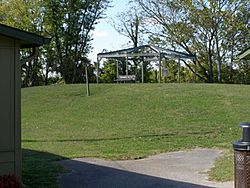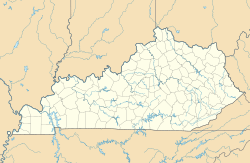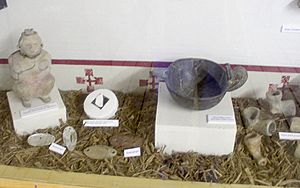Wickliffe Mounds facts for kids

Mound at the site
|
|
| Location | Ballard County, Kentucky, United States |
|---|---|
| Coordinates | 36°58′15.67″N 89°5′34.30″W / 36.9710194°N 89.0928611°W |
| History | |
| Founded | 1000 CE |
| Abandoned | 1350 |
| Cultures | Mississippian culture |
| Site notes | |
| Architecture | |
| Architectural styles | platform mounds, plazas |
| Architectural details | Number of temples: |
|
Wickliffe Site
|
|
| NRHP reference No. | 84000789 |
| Added to NRHP | December 08, 1984 |
| Responsible body: State | |
The Wickliffe Mounds is an ancient archaeological site in Ballard County, Kentucky. It was once a busy town built by the Mississippian culture people. This site is located near the town of Wickliffe. It is about 3 miles (4.8 km) from where the Ohio River and Mississippi River meet.
Archaeologists have studied Wickliffe Mounds. They found it is connected to other Mississippian sites along the Ohio River. Today, the site is a State Historic Site and has a museum. It helps visitors learn about the ancient community. Wickliffe Mounds is also listed on the National Register of Historic Places.
Contents
Life at Wickliffe Mounds: An Ancient Community
The ancient town at Wickliffe Mounds was built on a high bluff. This bluff overlooked the Ohio River. It was a very important place for the Mississippian people. It served as a center for ceremonies and for managing their society. At its busiest, hundreds of people lived here.
The site features two large platform mounds. There are also at least eight smaller mounds. These mounds are spread around a central open area called a plaza. The people grew maize, also known as corn, as their main food. Growing corn allowed more people to live together. It also helped create a structured society.
The Mississippian people at Wickliffe traded with groups far away. They traded with people from places like North Carolina, Wisconsin, and the Gulf of Mexico. Like most Mississippian communities, Wickliffe had a social system. It was led by a chief whose position was passed down through their family.
When Did People Live Here?
People lived at Wickliffe Mounds for a long time. They were here from about 1000 CE to 1350 CE. Around 1300 CE, people slowly started to leave Wickliffe. They moved to another site called Twin Mounds. This new location was a few miles away. It was closer to where the Mississippi and Ohio rivers join.
Here's a timeline of the different periods at Wickliffe:
| Time Period | Years | What We Found |
|---|---|---|
| Early Wickliffe | 1100 - 1200 CE | Lots of "Old Town Red" pottery, some "Ramey Incised" pottery. |
| Middle Wickliffe | 1200 - 1250 CE | Less "Old Town Red" pottery, some "O'Byam Incised var. Adams" pottery. |
| Late Wickliffe | 1250 - 1350 CE | More "Old Town Red" pottery, "O'Byam Incised var. Incised" pottery. Also, special pottery like "Nashville Negative Painted" and "Winterville". |
Discovering the Past: Excavations at Wickliffe
People first started digging at the site around 1913. These early digs were done by people who loved history and collecting artifacts. In 1932, a man named Fain W. King, who was an amateur archaeologist, paid for more serious excavations. These digs focused on three mounds and a burial area.
Mr. King and his wife, Blanche Busey King, later opened the site to tourists. They called it "Ancient Buried City." They wanted to share the history with the public. They also charged a small fee to help cover the costs of running the site.
Over time, the site changed hands. In 1946, the Kings gave the site to a hospital in Paducah. The hospital continued to run it as a tourist attraction until 1983. That year, the hospital donated the site to Murray State University. The university used it for research and to teach students about archaeology.
In 1984, Wickliffe Mounds was recognized as a very important historical place. It was added to the National Register of Historic Places. Then, in 2004, it became a Kentucky State Park. This means the state now protects and manages the site.
Today, the museum park helps visitors understand the ancient community. It shows amazing pottery and other items found at the site. There's also a large picture that shows what the Mississippian village might have looked like.
Exploring the Mounds
The Wickliffe Mounds site has several important mounds. Each one tells a different part of the community's story.
Mound A: The Ceremonial Center
Mound A is the largest mound at Wickliffe. It was the main place for important ceremonies. This mound was the heart of the community's political and religious life. Archaeologists have found that Mound A was built in six different stages over time.
Mound B: Homes of the Past
Mound B was once a residential area. This means people lived here. This mound was built up over 200 years. Until 2016, visitors could see the different layers of this mound. These layers showed signs of homes, like burnt materials from cooking fires. They also showed holes where wooden poles once stood. These poles supported the walls of houses made from wattle and daub (a mix of woven branches and mud).
Mound C: The Community Burial Ground
Mound C was the community's burial ground. It was where people were laid to rest. Today, Native American traditions are respected. The original human remains have been reburied. Instead, artificial skeletons are placed to show how the burials looked. This allows visitors to learn without disturbing sacred sites. Many infants were buried here, along with people who had health issues like arthritis and tuberculosis.
Mound D: Early Village Life
Mound D shows an even earlier part of the village. This area was once filled with homes. Later, it was covered by an elongated mound. The excavations here reveal how early structures were arranged. They also show many infant burials from that time.
Connections to Other Mississippian Sites
Wickliffe Mounds is part of a group of Mississippian towns. These towns are found in the lower Ohio River valley. They include Kincaid, Tolu, and Angel Mounds. Archaeologists call this group the "Kincaid focus." They share similar pottery styles and town layouts.
The Kincaid and Angel sites are especially similar. They have matching town plans and artifacts. They are also close to each other. Because of these strong connections, some experts believe the people who built and lived in these towns were part of the same society.
Special painted and carved pottery has been found at all four sites. This pottery is made with shell-tempered clay. It ranges from rougher, smoothed surfaces to more polished, finer surfaces. Some common pottery styles include Angel Negative Painted and Matthews Incised.
See also






